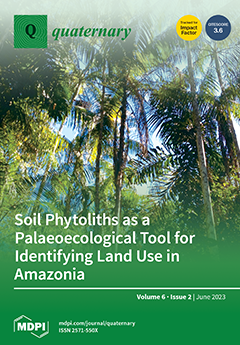Open AccessArticle
An Assessment of Soil Phytolith Analysis as a Palaeoecological Tool for Identifying Pre-Columbian Land Use in Amazonian Rainforests
by
James Hill, Stuart Black, Alejandro Araujo-Murakami, Rene Boot, Roel Brienen, Ted Feldpausch, John Leigue, Samaria Murakami, Abel Monteagudo, Guido Pardo, Marielos Peña-Claros, Oliver L. Phillips, Marisol Toledo, Vincent Vos, Pieter Zuidema and Francis E. Mayle
Cited by 3 | Viewed by 2650
Abstract
Phytolith analysis is a well-established archaeobotanical tool, having provided important insights into pre-Columbian crop cultivation and domestication across Amazonia through the Holocene. Yet, its use as a palaeoecological tool is in its infancy in Amazonia and its effectiveness for reconstructing pre-Columbian land-use beyond
[...] Read more.
Phytolith analysis is a well-established archaeobotanical tool, having provided important insights into pre-Columbian crop cultivation and domestication across Amazonia through the Holocene. Yet, its use as a palaeoecological tool is in its infancy in Amazonia and its effectiveness for reconstructing pre-Columbian land-use beyond archaeological sites (i.e., ‘off-site’) has so far received little critical attention. This paper examines both new and previously published soil phytolith data from SW Amazonia to assess the robustness of this proxy for reconstructing pre-Columbian land-use. We conducted the study via off-site soil pits radiating 7.5 km beyond a geoglyph in Acre state, Brazil, and 50 km beyond a ring-ditch in northern Bolivia, spanning the expected gradients in historical land-use intensity. We found that the spatio-temporal patterns in palm phytolith data across our soil-pit transects support the hypothesis that pre-Columbian peoples enriched their forests with palms over several millennia, although phytoliths are limited in their ability to capture small-scale crop cultivation and deforestation. Despite these drawbacks, we conclude that off-site soil phytolith analysis can provide novel insights into pre-Columbian land use, provided it is effectively integrated with other land-use (e.g., charcoal) and archaeological data.
Full article
►▼
Show Figures





